Capture the sweet fragrance of roses in this guide to making rose perfume. Whether you’re using fresh rose petals, dried roses, rosewater, or rose essential oil, you can create a unique and personal fragrance with these 9 simple rose perfume recipes.
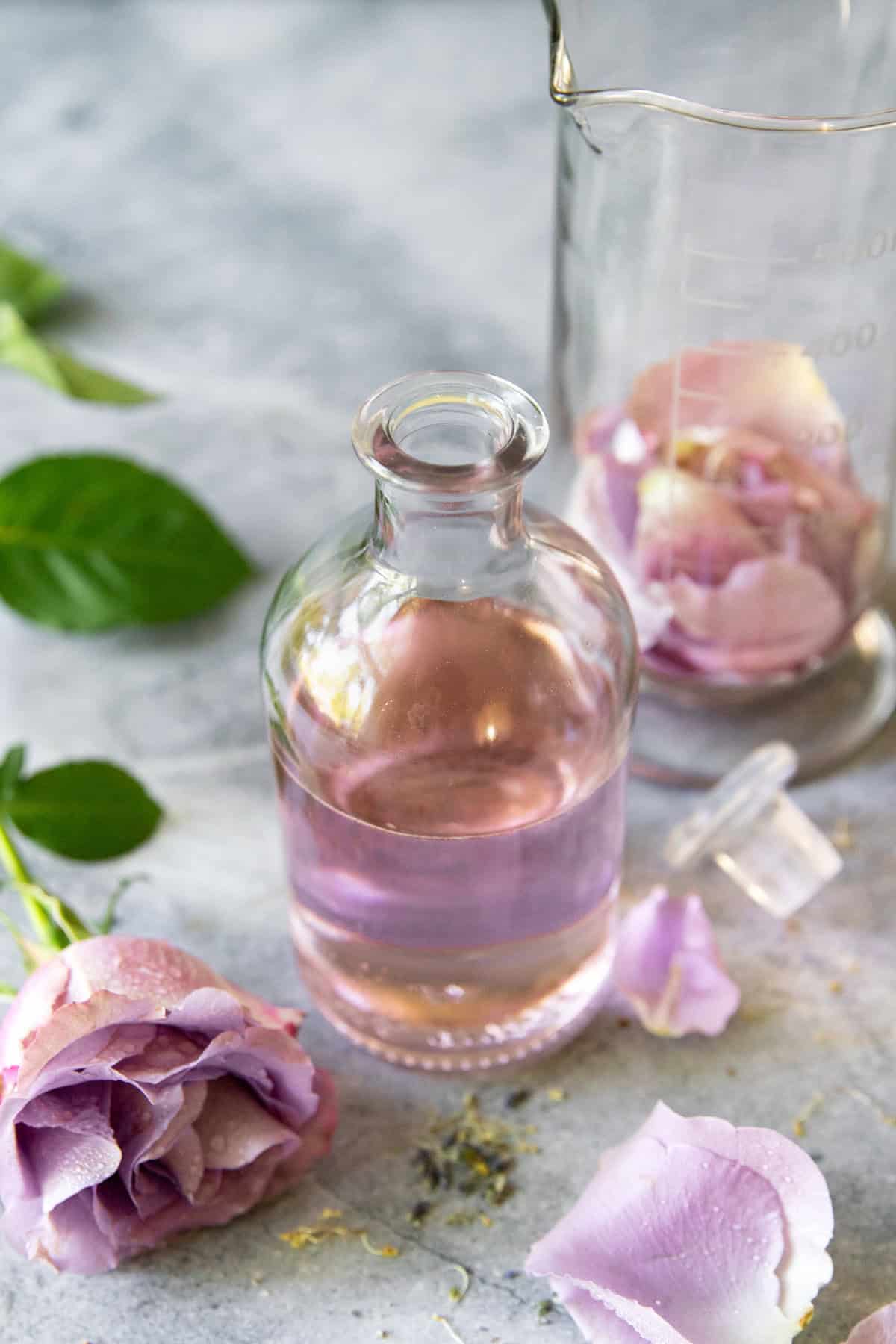
As a perfume enthusiast, I started crafting homemade perfume recipes more than a decade ago. Over the years, I've explored several fragrance-making techniques like blending essential oils, infusing botanicals, and distilling herbal and floral waters.
But roses just might be my favorite scent to work with! I love it so much that I use it in my floral-scented deodorant. These perfume methods are easy to try at home, so enjoy crafting your own signature scent!
Jump to:
- 1. Fresh Rose Petal Perfume
- Recipe: Rose + Lavender Perfume Oil
- Recipe: Rose Petal Botanical Cologne
- 2. Rose Essential Oil Perfume
- Recipe: Refreshing Rose Roll-On
- Recipe: Rose and Citrus Eau de Parfum
- Recipe: Rose and Jasmine Alcohol-Free Perfume
- 3. Rose Water Perfume
- Recipe: Rose + Sandalwood Aromatic Mist
- Recipe: Rose + Peppermint Refreshing Body Spray
- 4. Dried Rose Perfume
- Recipe: Dried Rose + Citrus Spice Perfume
- Recipe: Dried Rose + Vanilla Solid Perfume
- FAQ
1. Fresh Rose Petal Perfume

Use highly fragrant varieties like Damask or Bourbon roses for making perfume with fresh petals. If you’re using roses from your garden, early morning is the best time to pick them because that’s when their scent is most potent.
Recipe: Rose + Lavender Perfume Oil
Creating a rose-infused oil perfume is one of the easiest ways to make perfume using fresh roses. This romantic scented oil also infuses lavender, adding a crisp, clean layer to balance the floral notes.
Ingredients
- Fresh rose petals
- Dried organic lavender flowers
- A carrier oil, such as jojoba, almond, or grapeseed oil
- A clean, dry glass jar with a tight lid
- Cheesecloth or a fine mesh strainer
- A small dark glass bottle for storage
Instructions
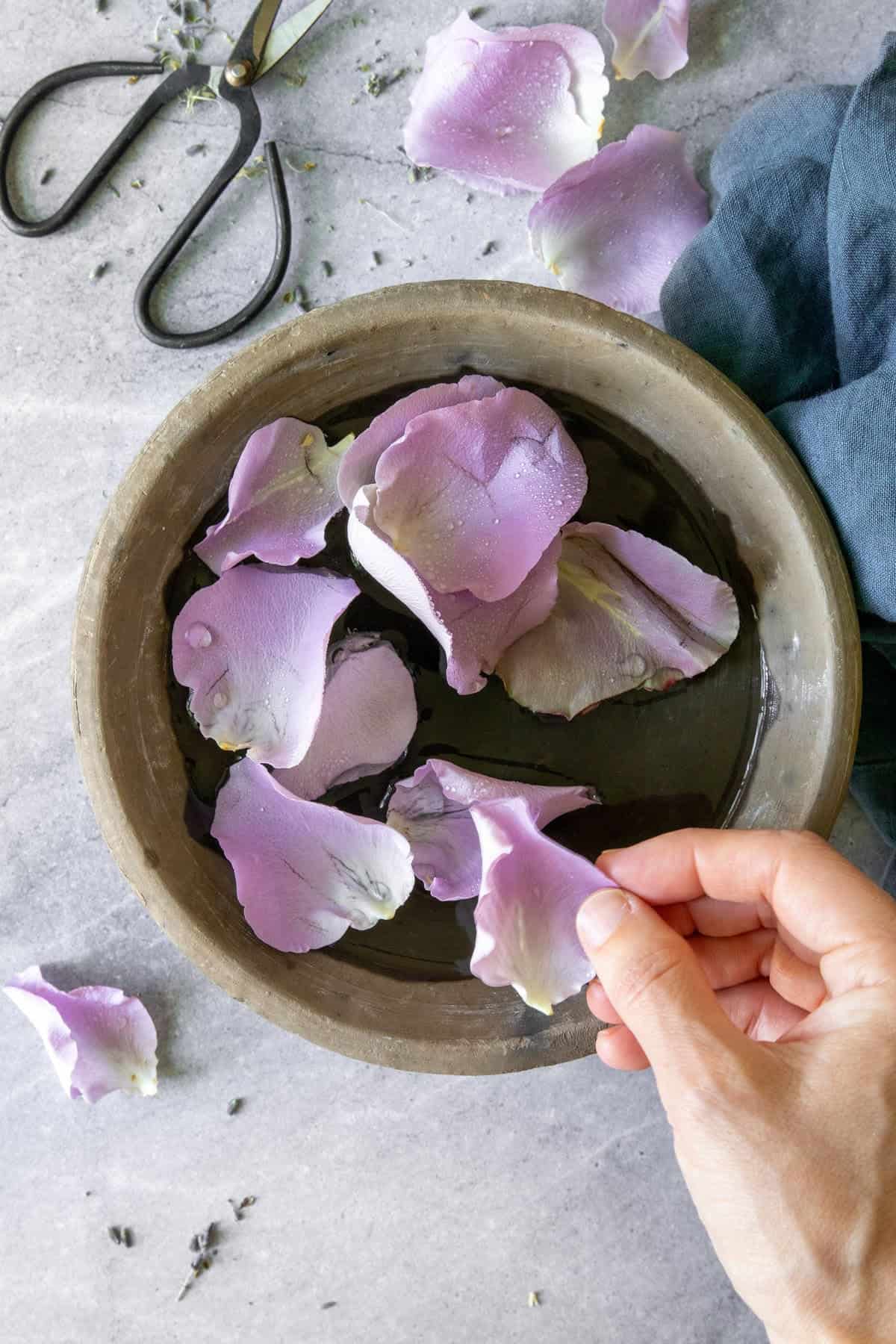
Step 1: Rinse + Dry Petals
Gently rinse the rose petals to remove any dirt or bugs. Pat them dry with a towel or let them air dry to minimize moisture (which can cause your oil to go rancid).
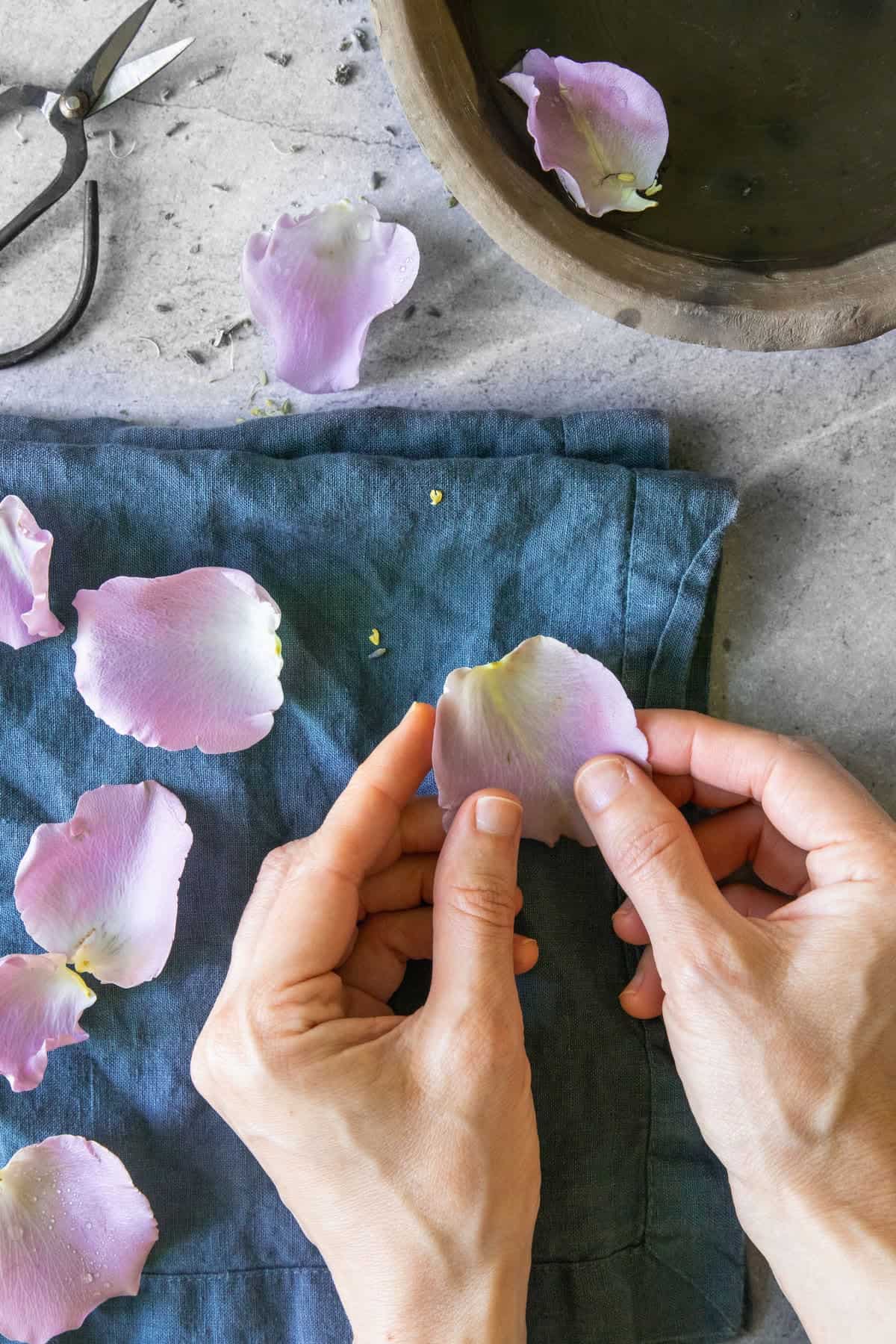
Step 2: Bruise Petals
Once dry, wash your hands thoroughly and lightly bruise the petals with your fingers to help release their fragrance. You don’t need to crush them; just a gentle press will do.
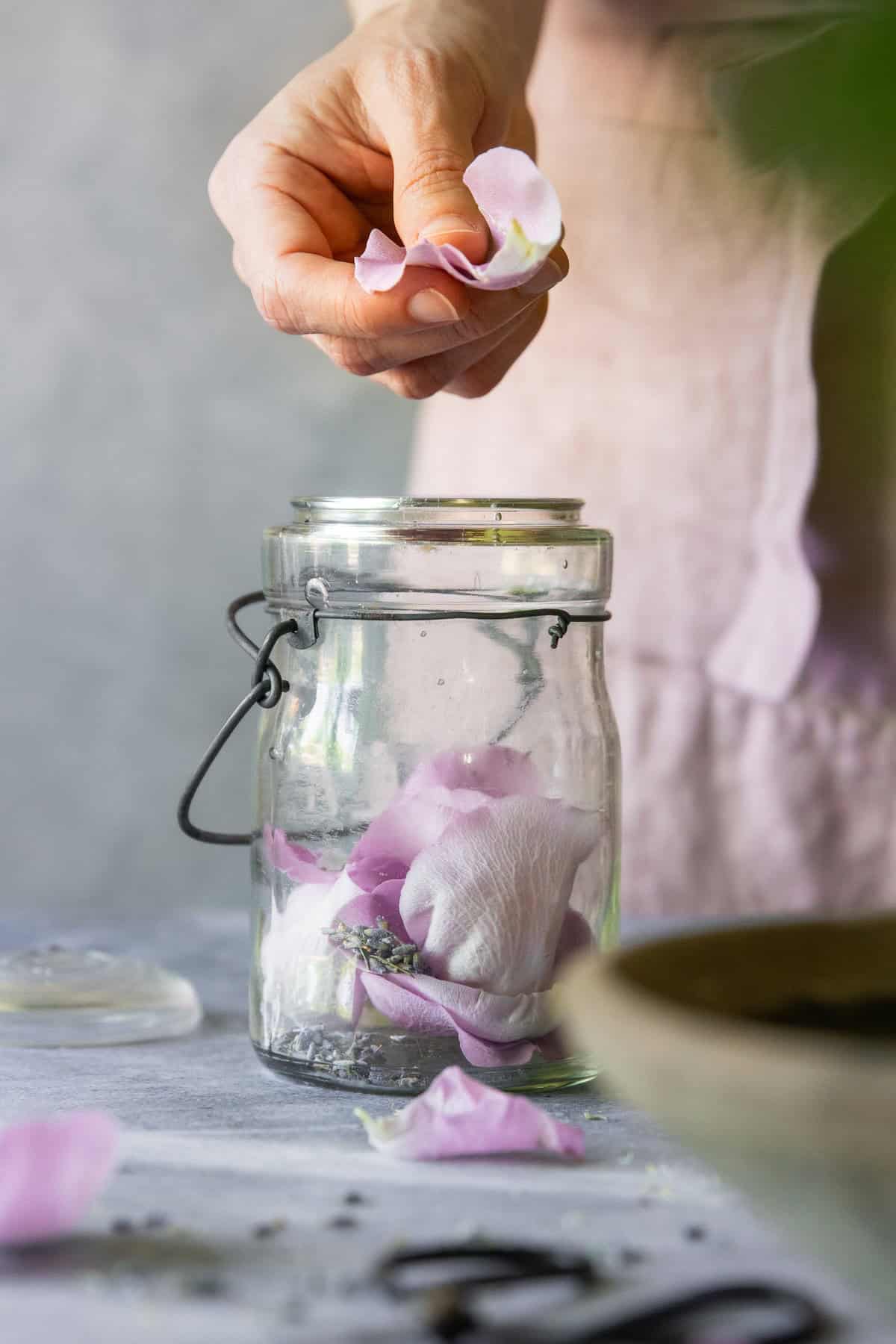
Step 3: Fill the Jar
Place the prepared petals in the glass jar, filling it about halfway. Pour the carrier oil over the petals until the jar is nearly full, making sure all the petals are submerged to prevent mold growth.
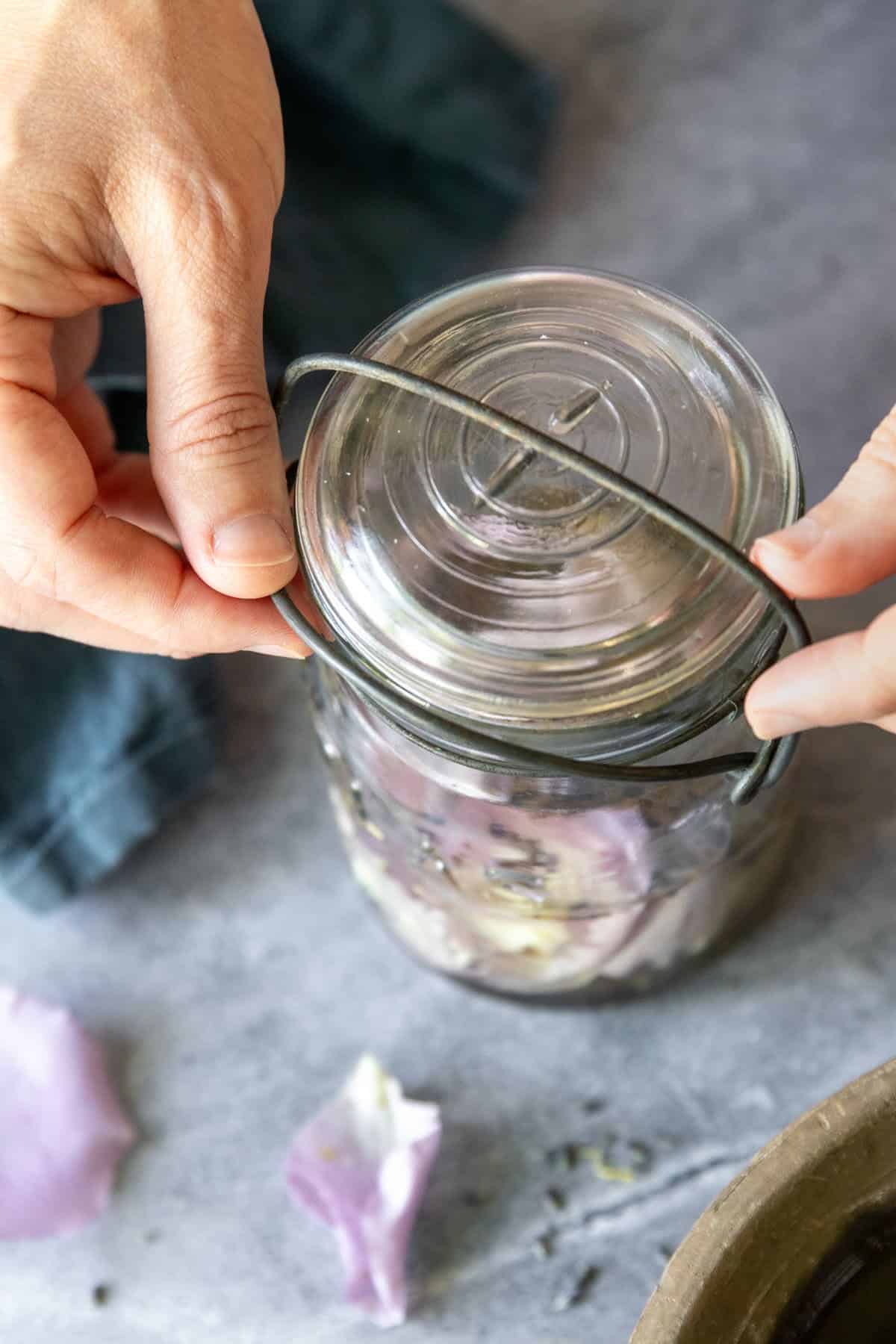
Step 4: Infuse the Oil
Seal the jar tightly and place it in a warm, sunny spot for at least 24 hours up to a few weeks. The longer it infuses, the stronger the scent will be. Shake the jar gently every day to help the infusion process.
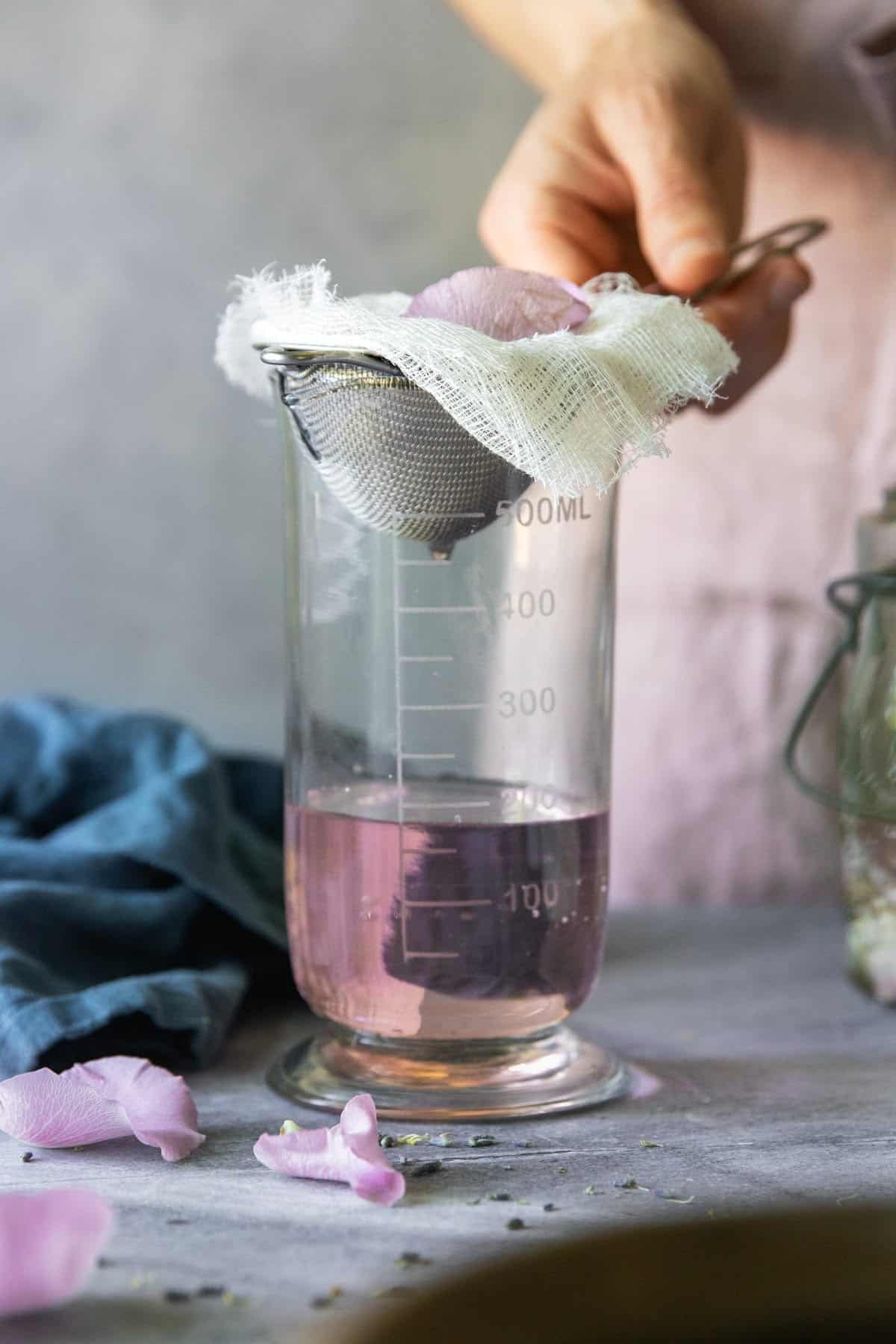
Step 5: Strain the Oil
After the infusion period, open the jar and strain the oil through a cheesecloth or fine mesh strainer into a clean bowl.
Squeeze or press the petals to extract as much oil as possible.

Step 6: Bottle the Perfume Oil
Transfer the strained oil into a dark glass bottle to preserve its fragrance. Label the bottle with the date and ingredients.
Apply a small amount to pulse points like your wrists, neck, and behind the ears.
Recipe: Rose Petal Botanical Cologne
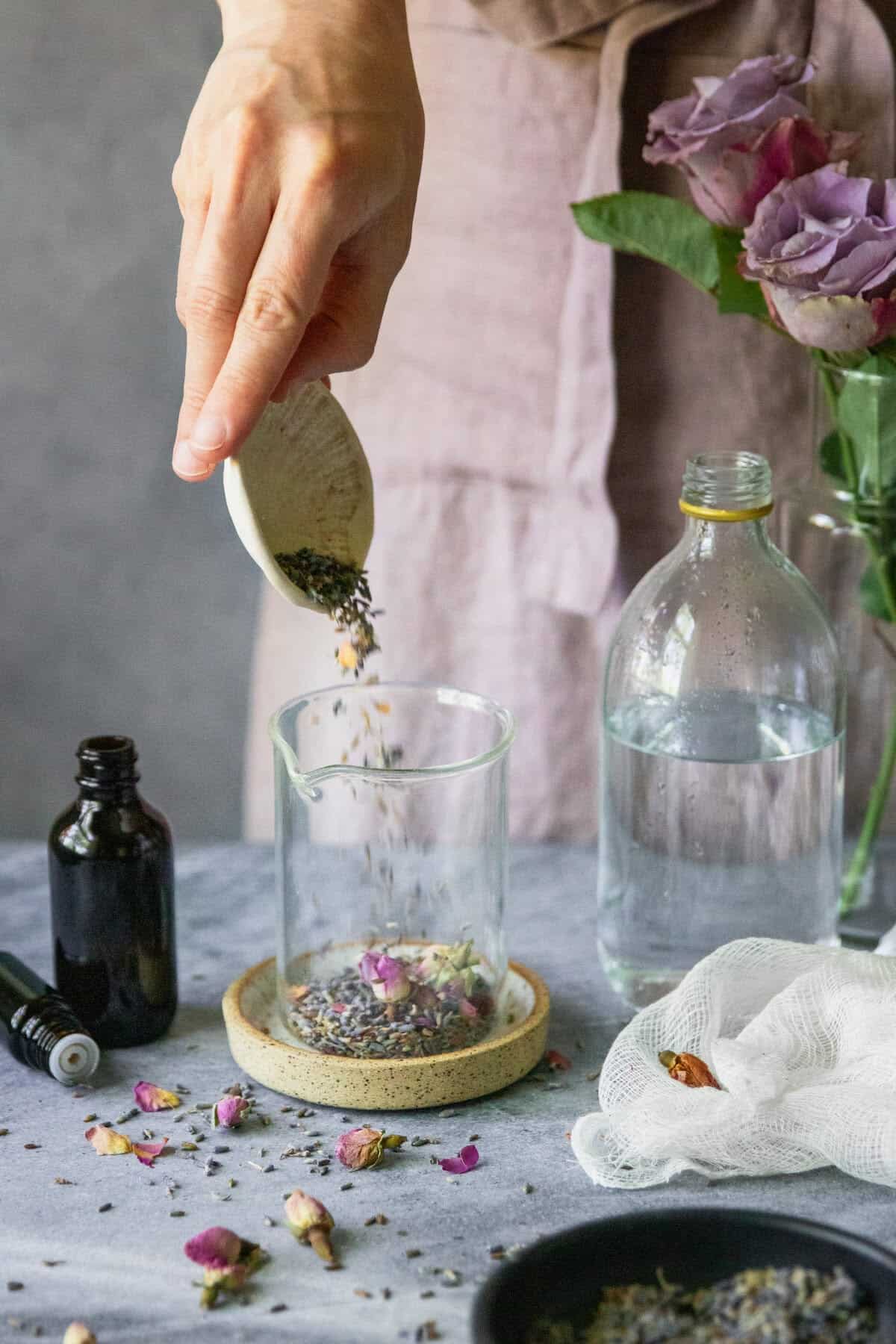
For a different approach to homemade rose petal perfume, you can make an alcohol-based perfume that uses vodka or a similar high-proof spirit to extract the rose scent. This recipe blends floral, citrus, and woodsy notes to capture the scent of a garden in bloom.
Ingredients
- 1 cup fresh rose petals (or organic dried rose petals)
- ½ cup dried organic lavender buds
- Peel of 1 organic lemon
- 2 cups high-proof alcohol (vodka or perfumer’s alcohol)
- 10 drops jasmine absolute
- 5 drops pre-diluted sandalwood essential oil
- 5 drops BF-free bergamot essential oil
- Distilled water (optional)
- A dark glass container that can be sealed
- A fine mesh strainer or cheesecloth
- Dark glass spray perfume bottles
Instructions
- Prepare the botanicals: If using fresh rose petals, gently rinse and pat them dry. Crush the rose petals and lavender buds slightly to release their essential oils. Carefully peel the lemon to avoid the white pith, which can introduce bitterness.
- Infusion: In the dark glass container, combine the rose petals, lavender buds, and lemon peel. Pour the high-proof alcohol over the botanicals until fully submerged. Seal the container tightly.
- Let it sit: Store the container in a cool, dark place for 4–6 weeks. Shake gently every few days to mix the ingredients.
- Strain: After the infusion period, strain the liquid through a fine mesh strainer or cheesecloth into a clean bowl, removing all botanical pieces.
- Add essential oils: To the strained liquid, add the jasmine, sandalwood, and bergamot essential oils.
- Dilute (optional): If you prefer a lighter scent, you can dilute the perfume with distilled water at this stage. A suggested starting ratio is 3:1 alcohol extract to water, but adjust according to your preference.
- Final strain and bottle: Strain the perfume one more time if you’ve added essential oils after diluting. Then, transfer the final product into dark glass perfume bottles to preserve the fragrance. A spray bottle can offer a fine mist, while a rollerball allows for targeted application.
- Cure: Let the bottled perfume cure for an additional 2–4 weeks in a cool, dark place to allow the scents to meld and mature.
2. Rose Essential Oil Perfume
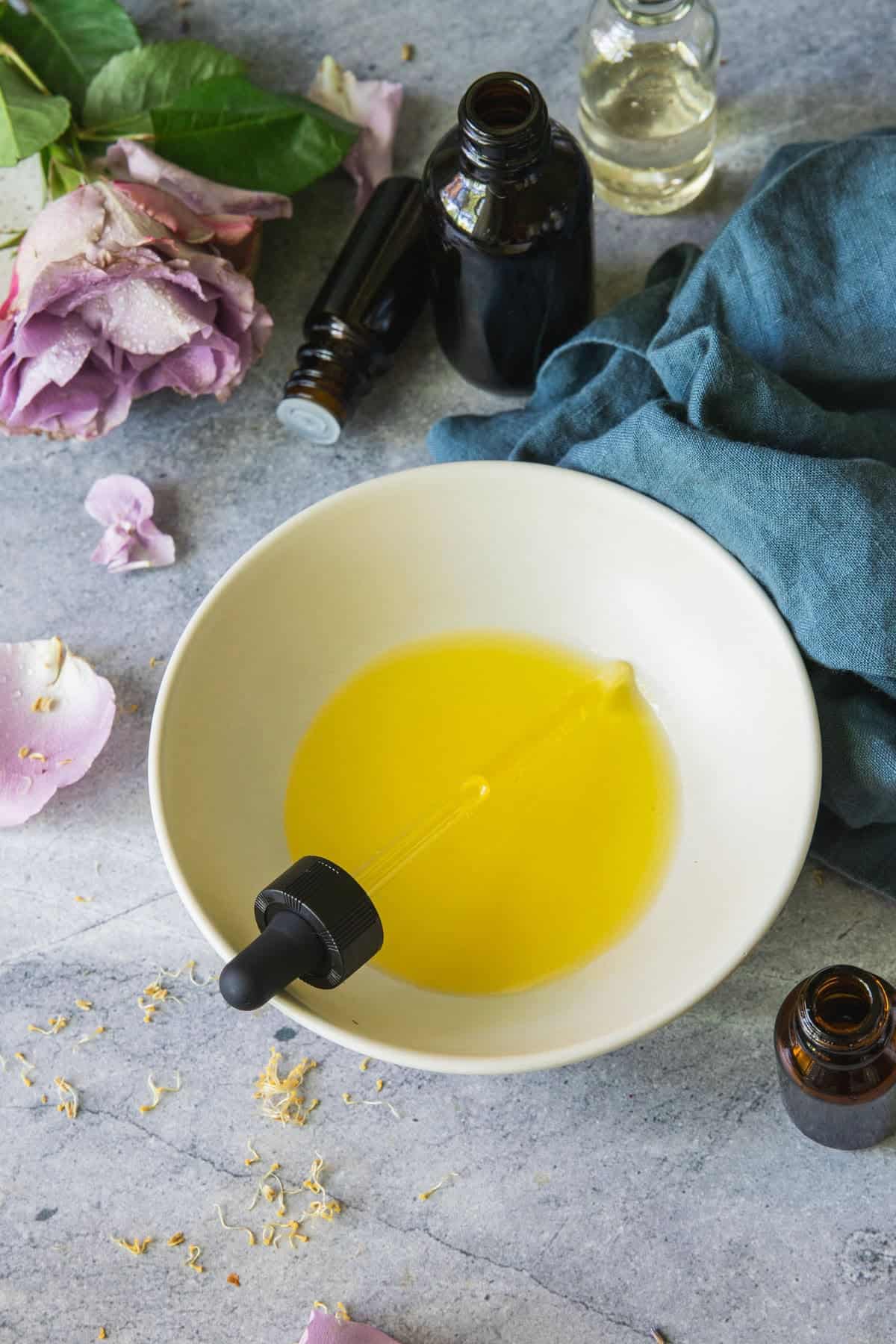
Creating rose perfume with essential oils cuts out the lengthy extraction process required when using fresh petals. Plus, you can blend rose essential oil with other essential oils in a carrier oil or alcohol base to create your own personalized perfume.
Recipe: Refreshing Rose Roll-On
This blend balances the classic floral scent of rose with fresh, spicy, and herbaceous notes.
Ingredients
- 5 drops rose absolute essential oil
- 3 drops frankincense essential oil
- 1 drop peppermint essential oil
- 2 drops clary sage essential oil
- 1 drop lemon essential oil
- Argan oil or sweet almond oil works well as the base for this blend, providing a light, non-greasy texture and additional skin benefits.
- 10 mL dark glass roller bottle
Instructions
- Create the essential oil mixture: Begin by combining the rose, frankincense, peppermint, clary sage, and lemon essential oils directly in the roller bottle. Shake gently to blend the oils. Give the mixture the sniff test and adjust if needed.
- Add the carrier oil: Fill your dark glass roller bottle with the chosen carrier oil.
- Mix thoroughly: After adding the cap and rollerball, shake the bottle well to ensure your essential oils are evenly distributed throughout the carrier oil.
- Let it mature: Allow the perfume oil to rest for at least 48 hours before using. This waiting period allows the different fragrance notes to meld together fully.
- Use: Apply to pulse points such as the inside of wrists, neck, and behind the ears.
Recipe: Rose and Citrus Eau de Parfum
Combine the floral notes of rose essential oil with the refreshing zest of citrus. The bright, tangy scent of grapefruit and lemon blends beautifully with the softness of the rose.
Ingredients
- Rose essential oil
- Grapefruit essential oil
- Lemon essential oil
- High-proof alcohol
- Distilled water (if making an alcohol-based spray perfume)
- Dark glass perfume spray bottle or roller bottle
Instructions
- Create your scent blend: In a small container, combine 20–30 drops of total essential oils, with rose being the predominant scent. You can adjust the proportions based on your scent preference.
- Mix with alcohol: Transfer this blend into a dark glass perfume bottle. Add about 1 ounce (30 mL) of high-proof alcohol.
- Dilute (optional): If you prefer a lighter scent or a sprayable perfume, you can add up to 2 ounces (60 mL) of distilled water to the mix.
- Let it mature: Seal the bottle and let your perfume sit for a few weeks in a cool, dark place. This aging process allows the scents to meld together, creating a more cohesive fragrance.
Recipe: Rose and Jasmine Alcohol-Free Perfume
For those sensitive to alcohol, mix rose and jasmine scents with glycerin and water to create a gentle, alcohol-free perfume. Jasmine’s exotic, intoxicating fragrance intensifies the rose, yielding a deeply floral and sweet scent.
Ingredients
- 10 drops rose absolute essential oil
- 5 drops jasmine absolute essential oil
- 1 tablespoon vegetable glycerin
- ¼ cup distilled water
Instructions
- Mix essential oils and glycerin: In a small bowl, combine the rose and jasmine absolutes with the vegetable glycerin. Stir thoroughly to ensure the oils are well distributed within the glycerin.
- Add water: Slowly add the distilled water to the glycerin mixture while stirring continuously. This gradual mixing helps to prevent the oils from separating.
- Bottle the perfume: Pour the mixture into a small glass spray bottle or atomizer. Glass is preferred as it preserves the integrity of the essential oils.
- Shake well: Shake the bottle vigorously to ensure all ingredients are well combined. Because oil and water naturally separate, shaking before each use will help to re-mix the perfume.
- Use: Spray directly onto the skin, focusing on pulse points, such as the wrists and neck. Reapply as needed throughout the day. As it contains water and no preservatives, try to use it within a month or two or add a natural preservative.
3. Rose Water Perfume

Yes, you can use rosewater to make a rose body spray that’s perfect for everyday wear, especially in warmer months when you want a light, refreshing fragrance.
Rosewater is essentially a byproduct of the distillation process of rose petals, capturing the delicate fragrance of roses in a less concentrated form. As a result, rosewater perfume will be more subtle and have a lighter scent compared to perfumes made with rose essential oil or absolutes.
Recipe: Rose + Sandalwood Aromatic Mist
Sandalwood’s earthy richness complements the rose’s delicacy, perfect for a soothing and sophisticated body spray. This type of perfume is ideal if you prefer a softer, more natural scent.
Ingredients
- ¼ cup rosewater
- 10–15 drops sandalwood essential oil (use a pre-diluted oil)
- ¼ teaspoon vegetable glycerin (optional)
- Glass spray bottle
Instructions
- Mix ingredients: Combine the ingredients in your glass spray bottle and give it a shake.
- Let it mature: For the best results, let your perfume sit for a few days in a cool, dark place. This allows the scents to meld together, creating a more unified fragrance.
- Use: Spray lightly on your skin, focusing on pulse points like your wrists, neck, and behind your ears. Since this perfume is lighter, you may need to reapply throughout the day to maintain the scent.
Recipe: Rose + Peppermint Refreshing Body Spray
Combine the soothing properties of rosewater with the cooling effect of peppermint oil. Add aloe vera juice for its moisturizing benefits, creating a refreshing body spray perfect for hot days or after sun care.
Ingredients
- ½ cup rosewater
- 4 drops peppermint essential oil
- 2 teaspoon aloe vera gel
- 4 oz glass spray bottle
Instructions
- Prepare the mixture: In a clean spray bottle, combine the rosewater and aloe vera juice.
- Add peppermint oil: Incorporate the peppermint essential oil into the mixture.
- Shake to combine: Secure the cap on the spray bottle and shake well to ensure all ingredients are thoroughly mixed.
- Chill: For an extra refreshing experience, especially on hot days or after sun exposure, refrigerate the body spray for an hour or so before use. Then, store it in the refrigerator to prolong the freshness.
- Use: Spray liberally over the body, avoiding the face and eyes, for a cooling and soothing effect.
4. Dried Rose Perfume
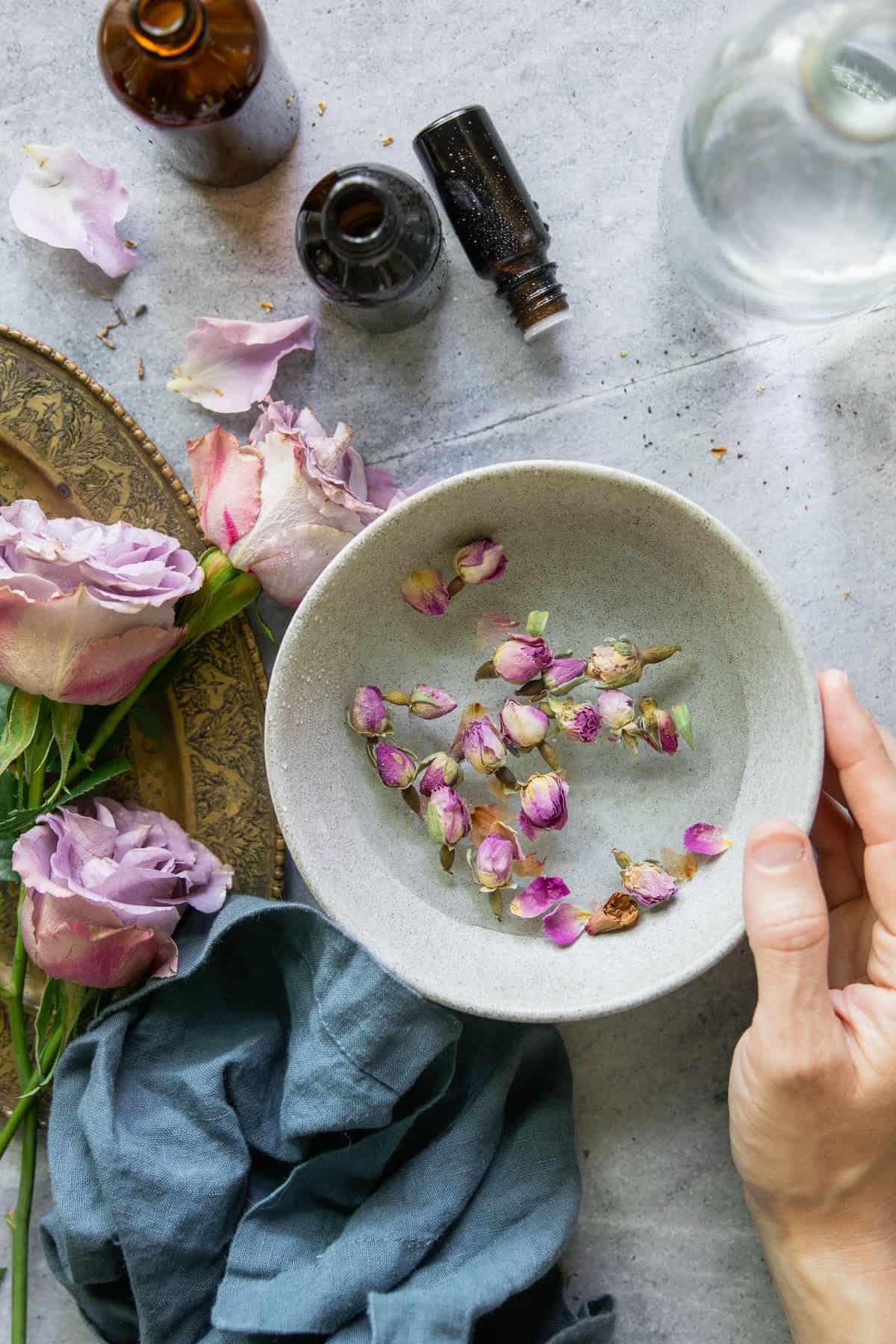
Dried roses retain much of the essential oils that give roses their fragrance. So, making perfume with dried roses is perfect if you want to use roses from your garden or preserve the scent of a special bouquet.
Recipe: Dried Rose + Citrus Spice Perfume
This perfume uses alcohol to extract the fragrance of dried roses and combines it with the warmth of spices and the freshness of citrus.
Ingredients
- ½ cup dried organic rose petals
- 1 cup high-proof alcohol
- 10 drops orange essential oil
- 5 drops patchouli essential oil
- 1–2 drops cinnamon bark essential oil
- Distilled water (optional)
- A dark glass container
- A fine mesh strainer or cheesecloth
- Dark glass perfume spray bottles
Instructions
- Infuse the dried roses: Place the dried rose petals in the dark glass container and cover them with high-proof alcohol. Seal the container and store it in a cool, dark place for 4–6 weeks, shaking gently every few days.
- Strain the infusion: After the infusion period, strain the alcohol through a fine mesh strainer or cheesecloth to remove all the rose petal solids.
- Add essential oils: To the rose-infused alcohol, add the orange, cinnamon bark, and patchouli essential oils. The orange and cinnamon essences create a warm, inviting top and middle note, while the more complex scent of patchouli adds a lasting depth.
- Dilute (optional): If you prefer a softer fragrance, you can dilute the perfume at this stage with distilled water. Adjust the amount of water according to your preference, but start with a small quantity to ensure it doesn’t overly dilute the perfume’s scent.
- Bottle the perfume: Transfer the final mixture into dark glass perfume bottles. If you’ve made a larger batch, using a funnel might help to avoid spills.
- Cure the perfume: Allow the perfume to mature for another 1–2 weeks in a cool, dark place to help the scents to meld together.
Recipe: Dried Rose + Vanilla Solid Perfume
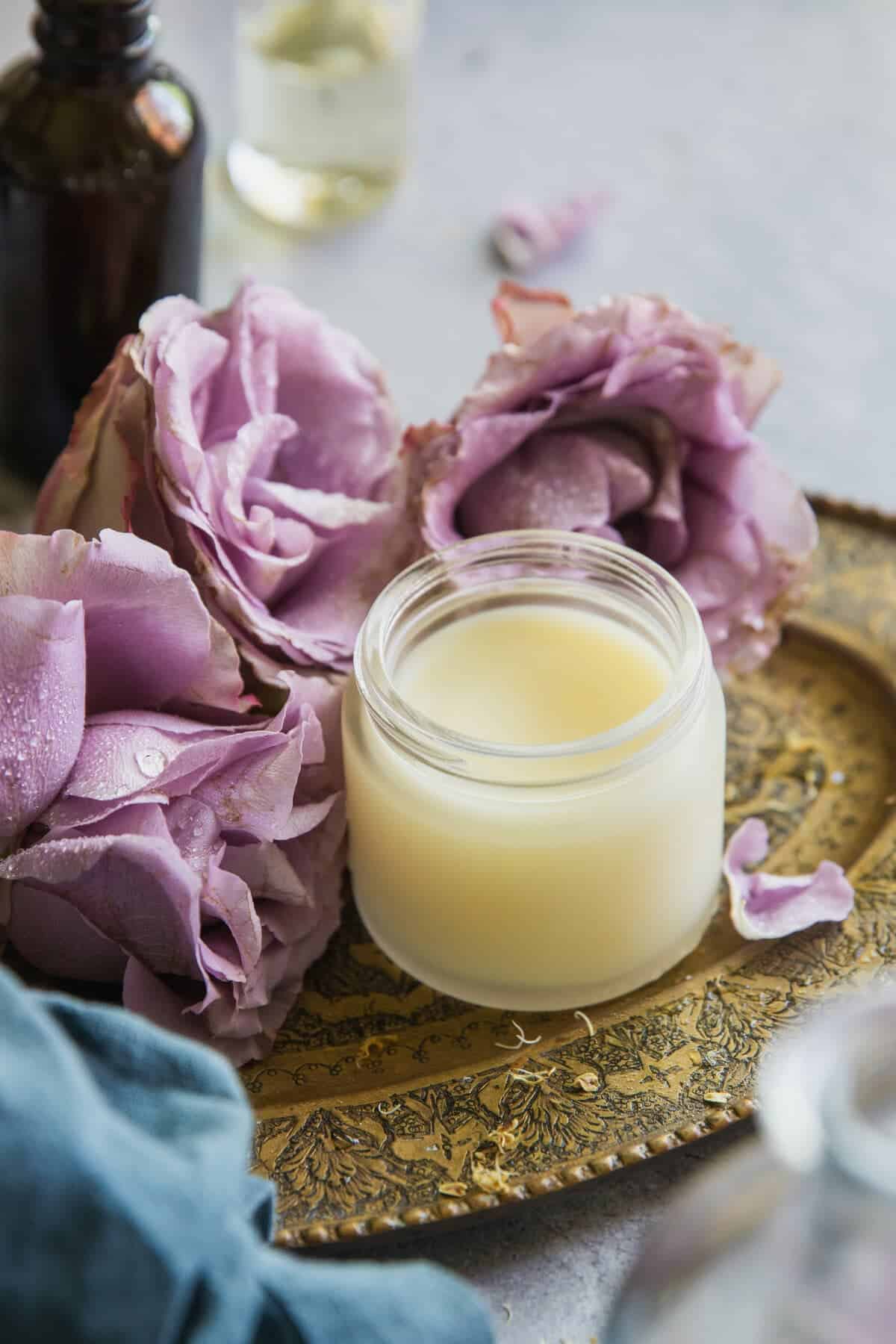
This rose and vanilla perfume has the added benefit of being easy to carry and apply on the go. The unique, tactile experience of solid perfume allows you to apply the scent exactly where you want it.
Ingredients
- 1 tablespoon dried organic rose petals
- ½ vanilla bean (or 5 drops vanilla absolute)
- 3 tablespoons sweet almond or jojoba oil
- 1 tablespoons beeswax
- 2 oz small tin or compact
- Double boiler (or a heat-safe bowl over a pot of simmering water)
Instructions
- Infuse the carrier oil: Combine the dried rose petals and the scraped contents of the vanilla bean with the sweet almond oil in a double boiler.
- Heat: Gently heat the mixture for 1–2 hours on the lowest heat setting, ensuring it doesn’t boil. This infuses the oil with the scents.
- Strain: Strain the oil through a fine mesh sieve or cheesecloth to remove the solid bits, and return the infused oil to the double boiler.
- Melt the beeswax: Add the beeswax to the infused carrier oil. Gently heat until the beeswax is completely melted, stirring occasionally.
- Combine ingredients: Once the beeswax is fully melted, remove the oil from the heat. If you’re using vanilla absolute, now is the time to add it to the mixture.
- Pour into container: Carefully pour the liquid perfume into your chosen tin or compact. Let it sit undisturbed until solidified, which can take a few hours. For a quicker setting, you can place it in the refrigerator.
- Use: To apply, rub a finger across the surface of the solid perfume and apply to pulse points like wrists, neck, and behind the ears.
FAQ
The best roses for perfume-making are those with a strong fragrance. Varieties like Damask, Bourbon, and Centifolia roses are known for their intense scents. It’s important to use organic roses to avoid chemicals and pesticides that can affect the perfume’s purity and safety.
Yes, dried roses can be used, especially if fresh, highly fragrant roses aren’t available. Ensure they are organic and still aromatic. However, the scent might be different and more subtle than fresh roses.
This can vary depending on the desired strength, but typically, the mixture should infuse for about 4 to 6 weeks. The longer you let it infuse, the stronger the fragrance will be.
Adding a fixative like glycerin can help. Natural fixatives such as benzoin resin, orris root, or even a bit of jojoba oil can also extend the longevity of the fragrance on your skin.
Commercial perfumes often contain synthetic fragrances and other additives that enhance their strength and longevity. Homemade perfumes, especially those made with natural ingredients, tend to be subtler and may not last as long without frequent reapplication.
Mix rosewater or rose essential oil with a carrier like jojoba oil or glycerin and water to create an alcohol-free perfume. This is particularly good for those who have sensitive skin or prefer a less intense fragrance.

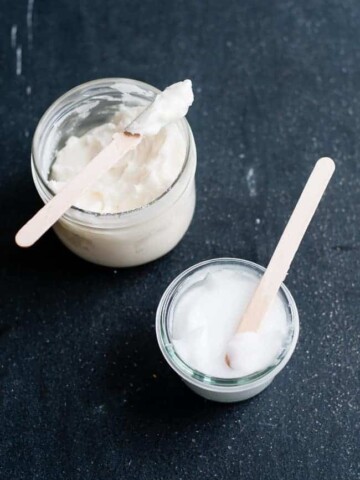
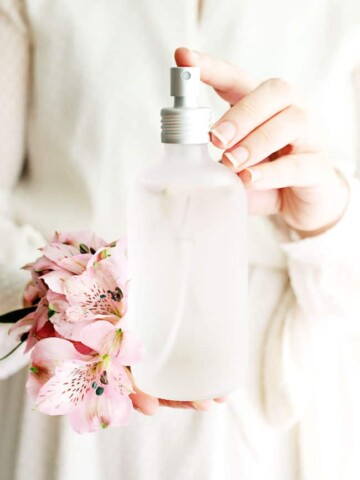
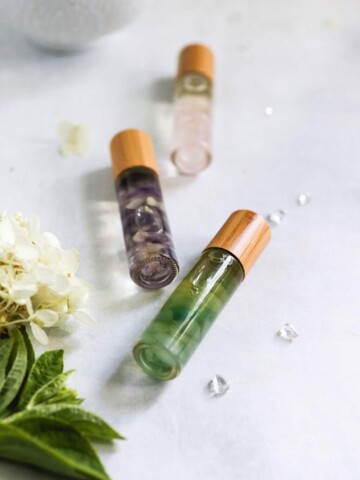
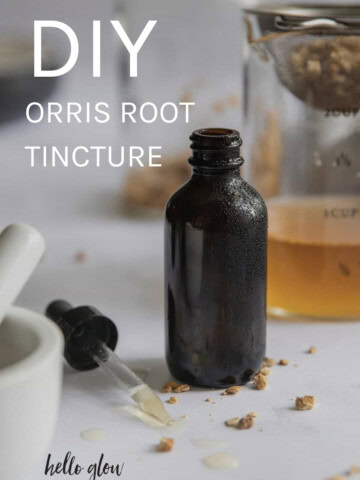
Leave a Comment